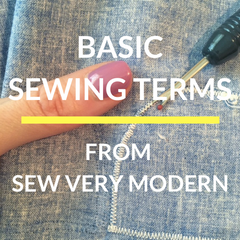Tuesday's Tip - Basic Sewing Terms
Posted by Bianca Howell on
When you start your sewing journey you start to see a lot of words that may seem like a foreign language to you. So, I would like to help you out and give you the meanings of some of the most basic sewing terms out there.

Baste - either by hand or machine, long stitches that are used, temporarily, to hold together two pieces of fabric so that they stay in place while you sew them together.
Bias - diagonally across the fabric grain. In woven fabric, this is where there will be the most stretch.
Bobbin - the spindle that is placed on the bottom of the sewing machine. The thread from the bobbin is what forms the lower part of the sewing machine stitches.
Fabric Grain - the layout of the threads that make up fabric. These threads run perpendicularly and parallel to the selvage.
Feed Dogs - the jagged, metal piece underneath the stitch plate that helps to push the fabric along by moving up and down.
Hem - the edge of a sewn item that is folded over at least once and sewn. A hem is used to enclose the raw edge of the fabric to avoid fraying.
Muslin - fabric that is used to create a sewing pattern prototype, usually an un-treated or un-dyed piece of fabric, in order to be able to fix mistakes and improve fitting.
Presser Foot - part of the sewing machine that holds the fabric is place while you sew.
Seam Allowance - the area of fabric between the edge of the fabric and the seam, the stitches. Typically, it's 1/4 inch for quilting and 5/8 inch for apparel sewing.
Seam Ripper - a sewing tool that has a pointed edge to help you remove stitches from a piece of fabric.
Selvage - the raw edges that run along the grain of the fabric.
Sewing Notion - a tool used for sewing, as well as an item sewn to fabric such as a button or snap.
Warp - the threads that run along the length of the fabric, up and down.
Weft - the threads that run along the width of the fabric, side to side.
Being familiar with sewing and quilting vocabulary will help make your experiences with patterns, tutorials and sewing classes much easier. While these selected terms are just a start, I hope this encourages you to explore more!
